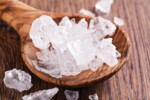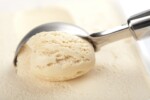Enzymes are specialized biological catalysts that complete biological work within cells. In this activity, students investigate the effect of pepsin, a protease, on albumin, an abundance protein in animal cells. Pepsin, an enzyme found in the digestive tracts of animals, catalyzes the digestion of food proteins into peptides containing essential amino acids. The rate at which enzymes function is influenced by several factors, including environmental temperature, environmental pH, ion concentration, presence of inhibitory chemicals, and concentrations of the enzyme or its substrate.
Materials
-
- Albumin Suspension (see “Teacher preparation” section below)
-
- Distilled Water
Teacher preparation
- Prepare an albumin suspension by separating egg whites (albumin) from yolks and adding 20 mL of distilled water to the albumin. You can use 1 egg for every 4 lab groups.
- Prepare 0.1 M hydrochloric acid solution and 1% pepsin solution. To prepare your 1% pepsin solution, dissolve 0.1 g of powdered pepsin in 9.9 mL of distilled water.
Safety
This activity requires the use of hazardous components. Be sure to review all district and department guidelines involving the use of the materials listed above.
Procedure
- Label 5 test tubes “1,” “2,” “3,” “4,” and “5.”
- Place about 5 mL of egg white (albumin) suspension into each test tube.
- Add 3 drops of dilute hydrochloric acid to tubes 3 and 4.
- Using a syringe, place 1 mL of 1% pepsin solution in a clean test tube and heat it over a small Bunsen flame until the liquid boils. Add the boiled pepsin to the egg white suspension in tube 5.
- Fill the 250-mL beaker halfway with water. Place the beaker on a hot plate to prepare a water bath that will sustain a temperature of about 40° C.
- Add 1 mL of 1% pepsin solution to tubes 2 and 4 only.
- Place all 5 tubes in the water bath for 5 minutes.
- After 5 minutes, remove the tubes from the water bath and replace them in the test tube rack. Compare the appearance of the contents and fill in your table of results.
Data Table
| Tube | Contents | Results |
| 1 | Egg white suspension only | |
| 2 | Egg white suspension + pepsin | |
| 3 | Egg white suspension + HCI | |
| 4 | Egg white suspension + pepsin + HCI | |
| 5 | Egg white suspension + boiled pepsin |
Sample Data Table*
| Tube | Contents | Results (expected) |
| 1 | Egg white suspension only | Milky appearance |
| 2 | Egg white suspension + pepsin | Cloudy |
| 3 | Egg white suspension + HCI | Milky appearance |
| 4 | Egg white suspension + pepsin + HCI | Clear |
| 5 | Egg white suspension + boiled pepsin | Milky appearance |
*results will vary
Conclusion
The suspension turns from a cloudy, milky appearance to clear as pepsin, a protease, breaks down the albumin. Students should observe that pepsin appears to function more effectively at an acidic pH when compared with the other groups. Tube 4 models conditions present in the stomachs of animals during digestion. The results of this investigation should lead students to additional questions regarding the conditions under which enzymes are able to function.
Extensions
-
- Students can design an experiment to show how enzyme activity is influenced by other factors (such as temperature, light, or competing chemicals).
- Students can design an experiment to test the effect of antacid products on the digestion of proteins in the stomach.
About The Author
Carolina Staff
Carolina is teamed with teachers and continually provides valuable resources–articles, activities, and how-to videos–to help teachers in their classroom.



